If you are looking for the best dumbbell exercises to train your back and bicep at home or the gym, then you are in the right place.
The dumbbell back and bicep workout routines are effective ways to build mass and strength in the latissimus dorsi, lower back, rhomboids, both heads of the biceps, and forearms.
It doesn’t matter whether you are a beginner or an advanced gym lifter. You need a good workout routine to optimize your muscle gains.
I’m super excited to share with you my all-time favorite (based on science and experience) back and biceps exercises with workout routines. Trust me, once you try this power pair, you’ll wonder why you didn’t start sooner.
We’ll break down exercises for every muscle group, with options for gym and home warriors (because, let’s face it, sometimes the gym isn’t an option).
Let’s do this!
Want to take your gains to the next level? Discover your daily calorie needs with our free TDEE calculator
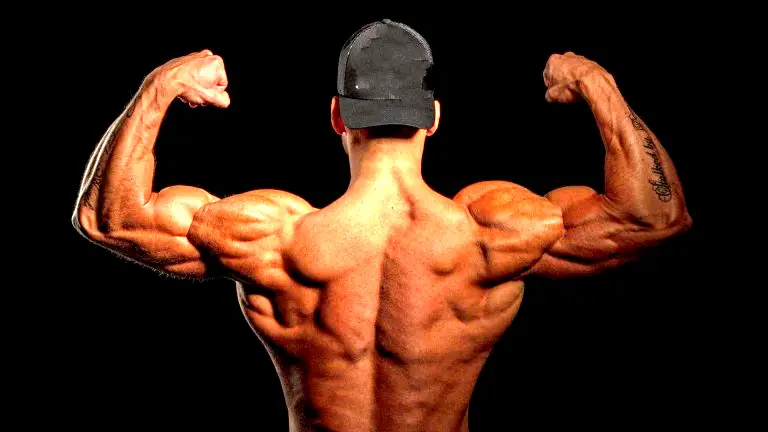
- Why You Should Train Back And Biceps Together
- 10 Best Back and Bicep Dumbbell Workouts for Mass and Strength
- 1. Dumbbell Deadlift
- 2. One-Arm Dumbbell Row
- 3. Dumbbell Bent Over Row
- 4. Dumbbell Upright Row
- 5. Renegade Row
- 6. Standing Dumbbell Curl
- 7. Dumbbell Reverse Curl
- 8. Concentration Curl
- 9. Hammer Curl
- 10. Zottman Curl
- How To Plan Dumbbell Back And Biceps Workout Routine
- 1. Select Sets And Reps
- 2. Select Workout Splits
- 3. Back And Bicep Dumbbell Workout For Beginner
- 4. Single Dumbbell Back And Bicep Workout Plan
- 5. Back and Bicep Superset Workout Plan
- FAQs
- is back and biceps a good workout?
- How long should a back and bicep workout be?
- Back and bicep Dumbbell workout Dumbbell at home
- How frequently should I train my back and bicep?
- Conclusion
- Best Back and Bicep Workout For Mass And Strength
Why You Should Train Back And Biceps Together
Training your back and biceps together in the same workout is something very common in today’s bodybuilding training routines. It does not matter whether you are a beginner or an advanced lifter, or if you are doing it at home or in a gym.
When you perform compound back exercises, multiple muscles work together to execute the movement effectively. This includes targeted primary muscles and the synergistic and stabilizer muscles.
For instance, when you do a dumbbell row, the back is the main targeted muscle. However, many other Synergistic and stabilizer muscles act in this motion, such as the Biceps brachii, rear deltoid, and traps.
During a compound back workout, many targeted muscles work together with other Synergistic and stabilizer muscles to function.
This meta-analysis found compound exercises were more effective at building muscle mass than isolation exercises. This means they maximize workout efficiency and muscle growth potential.
By continuing to work your biceps after back exercises, you’re using the pre-exhaustion principle, where muscles tired by compound movements are fully exhausted by isolation exercises.
10 Best Back and Bicep Dumbbell Workouts for Mass and Strength
Here are 10 exercises you can do with dumbbells to build back and biceps muscles. These exercises can be used as part of a regular workout or as a standalone circuit.
1. Dumbbell Deadlift
If you work out at home and do not have access to a barbell, a dumbbell deadlift is an effective way to train your back and biceps.
The deadlift is the best exercise for posterior chain muscle strengthening. The dumbbell deadlift is a compound exercise that primarily targets the muscles in your lower back, glutes, hamstrings, and core and bicep muscles.
One of the biggest benefits of using dumbbells for deadlifts is that you can work with a wider range of motion than with barbell deadlifts.
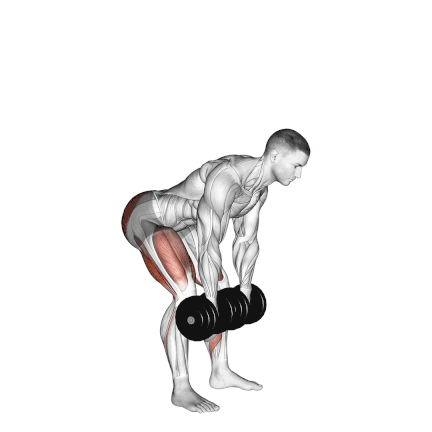
Execution Technique
- Place a dumbbell in front of you. Grab the Dumbbells with each of your hands.
- Remember to keep your back as straight as possible.
- Lift the dumbbell from the ground. Raise it up so that you’re standing up straight.
- Do not hyperextend your body as the weight shifts to the lumbar spine.
- Now, lower the dumbbell slowly and steadily at a slow pace by bending at the hips first and then at the knees.
- Let the weight almost touch the ground before you begin the next rep.
Tips
- Don’t just lift the weight halfway; finish the lift.
- If a deadlift is performed incorrectly, it can have more negative effects than positive ones. Always keep your back straight.
- Ensure you are going through the full range of motion and keeping your form correct.
- Make sure your movements are smooth and controlled.
2. One-Arm Dumbbell Row
One-arm dumbbell Row is an excellent full-range exercise for building the lats muscles. It’s great if you only have a single dumbbell.
This helps to work on each side independently, providing better muscle isolation and a longer range of motion. And greater hypertrophy.
It is an excellent alternative to the barbell rows. You must add this back and bicep dumbbell workout to your exercise arsenal.
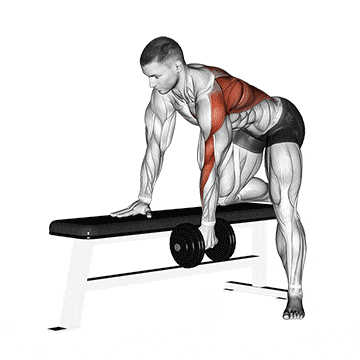
Execution Technique
- Grasp a dumbbell with palm facing in.
- Rest the opposite hand and knee on a bench, keeping your spine straight and just above parallel to the floor.
- Pull the dumbbell vertically upward alongside your torso, raising the elbow as high as possible.
- Lower the dumbbell as slowly as possible, feeling a good stretch in your lats.
- For better isolation, keep motion under strict control.
- Repeat on the other side.
3. Dumbbell Bent Over Row
The dumbbell bent over row is a fantastic compound exercise that primarily targets the muscles in your upper back (especially the lats), rear deltoids, rhomboids, and biceps.
The dumbbell row is a variation of the barbell bent-over row that can easily be done at home with only a pair of dumbbells.
Dumbbell bent-over rows allow for a greater range of motion than barbell bent-over rows. This is because you can bring the dumbbells closer to your body, which helps to target the lats and rhomboids more effectively.
- Raising the dumbbell higher toward the chest focuses on the upper latissimus and trapezius.
- Pulling the dumbbell through a lower trajectory to touch the abdomen targets the lower lats.
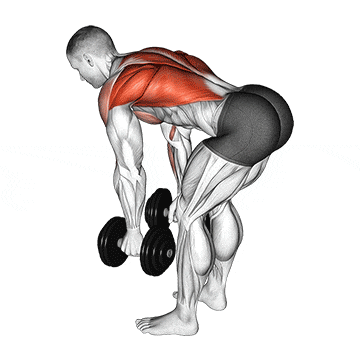
Execution Technique
- Stand with a narrow stance and a dumbbell with a neutral grip in each hand.
- Bend your torso forward at an angle of 45 degrees to the floor with your knees slightly bent.
- Now, use the back and raise the dumbbell until it touches the abdominal region and not the chest region, as it reduces back muscle contraction.
- Slowly lower the dumbbell. Keep movement always under control without letting gravity take you down faster.
4. Dumbbell Upright Row
The upright row is a compound exercise that targets the muscles in your shoulders (deltoids), traps (trapezius), and the upper back.
Dumbbell upright rows can be done with various grip widths and hand positions, which can help target multiple muscle groups. This makes them a more versatile exercise than barbell upright rows.
If you only have one dumbbell, try the single arm upright row.
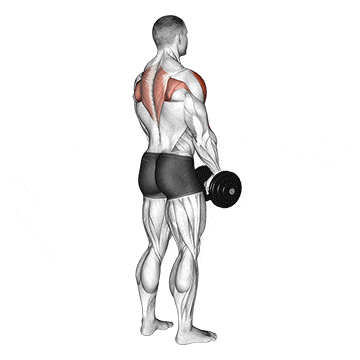
Execution Technique
- Stand with your feet shoulder-width apart and bend your knees slightly.
- Hold a dumbbell in each hand with an overhand grip.
- Slowly pull the dumbbells up toward your lower chest while keeping the dumbbells close to your body.
- Keep your elbows higher than your forearms.
- At the top, pause for a moment and contract the muscles.
- Now, slowly lower the dumbbell back to the starting position.
5. Renegade Row
The renegade row is also called a plank row, almost the same as a dumbbell row. It is designed to target the upper back and bicep and, like a plank, it also strengthens the core.
The renegade row is a multitasking exercise that tones your back and arms, works your core, and tests your balance and stability.
It is the best strength-training move and will give you a big back.
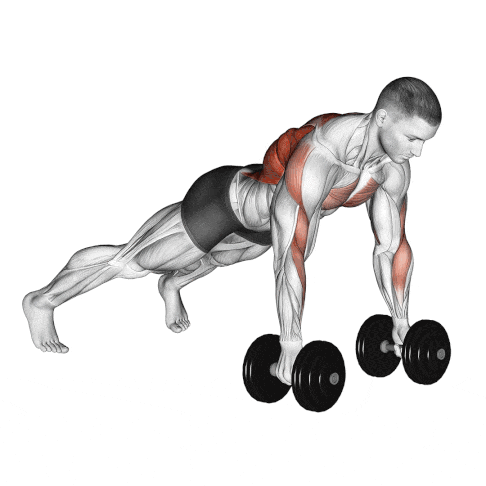
Execution Technique
- Place two dumbbells on the floor about shoulder-width apart.
- Keep your body straight from your shoulders to your ankles as you row the weight.
- Start at the top of a push-up position with your hands on the weights.
- Pull your right elbow back, raising the dumbbell toward your chest. Keep your right elbow close to your torso, your abs tight, and your hips in one line.
- Hold for one second at the top and return the weight slowly to the starting position to repeat on the other side.
6. Standing Dumbbell Curl
Standing dumbbell curls work the biceps muscles at the front of the upper arm and the brachialis and brachioradialis muscles in the lower arm.
When you do the standing arm curl, you build strength in your upper arm and learn to use your arm muscles correctly, bracing with your core muscles.
The dumbbell curl is the best exercise you can add to your back and bicep dumbbell workout routine to build mass.
Other Variation of it: Alternate dumbbell curl, Arm one dumbbell curls.
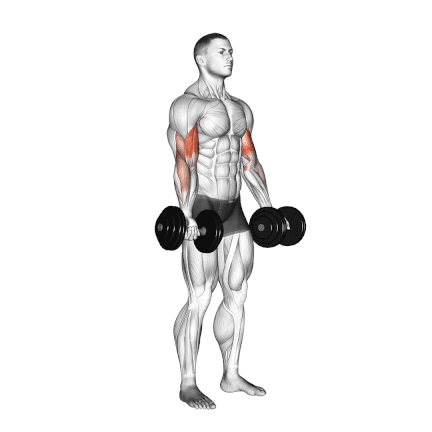
Execution Technique
- Stand straight, keeping feet shoulder-width apart, and grab a pair of dumbbells by your side.
- The dumbbells should not be touching your body.
- Your palms should be facing upward. Take up the slack by bending the elbows slightly. Tension should be on the biceps.
- Slowly curl the dumbbells up as far as possible.
- Then, slowly lower the dumbbells back down to the starting position.
7. Dumbbell Reverse Curl
The reverse dumbbell curl is a variation of the standard bicep curl. In this variation, the dumbbell is gripped palms up (overhand grip). The motion is the same, but the change in grip allows for specific arm muscles (brachialis and brachioradialis) to be targeted.
Reverse dumbbell curls are a classic biceps curl exercise that has been used for decades by bodybuilders and strength athletes. They are a highly effective way to target the forearm and bicep muscles.

Execution Technique
- Stand straight, and keep your feet shoulder-width apart.
- Grab a dumbbell with an overhand grip and arms should be extended.
- Curl the weights up towards your shoulders and exhale as you do so.
- Continue curling the dumbbells up until they are at shoulder level and your biceps are fully contracted.
- Return to the starting position in a smooth arc, and inhale as you do so.
- Using a slower eccentric phase of the exercise can help to improve tension and mind-muscle connection.
8. Concentration Curl
The concentration curl is the best exercise for building a biceps peak. It should be part of your arms race, as peaked biceps are impressive.
This exercise is done standing or seated with a bent torso, using a single dumbbell. Resting the upper arm against the thigh prevents movement at the shoulder and is an excellent way to isolate the biceps.
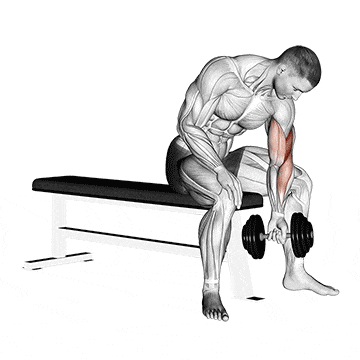
Execution Technique
- Hold a dumbbell in your hand and rest your other arm on your knee while you bend down.
- Curl your arms to the maximum and twist your wrist so the little finger is lower than the thumb.
- Curl the dumbbell back to the start position.
- Breathe out when you exert yourself.
- Repeat the desired number of sets.
9. Hammer Curl
The Hammer curl is a classic weightlifting exercise that targets the biceps and forearms. It is different from a regular bicep curl because it uses a neutral grip instead of an underhand grip.
When It comes to building muscular hypertrophy and strength, the hammer curl exercise is one of the most popular exercises among bodybuilders and regular weightlifters.

Execution Technique
- Stand with your feet shoulder-width apart and a slight bend in your knees.
- Hold a pair of dumbbells with your palms facing towards your body and place them on your body.
- Keep your elbows close to you as you slowly raise the dumbbell to your shoulders.
- Pause at the top of the lift for a second, squeeze your biceps, and then lower the weights under control.
- Neither leans back as you lift the weight nor forward as you lower it.
10. Zottman Curl
The dumbbell zottman curl is one of the best variations of the standard bicep curl.
The zottman curl targets your biceps and forearms at the same time. It utilizes different hand positioning to varying portions of the lift.
- The first portion, the regular curl, focuses on bicep strength.
- The second lowering portion, the dumbbell reverse curl, allows you to overload the forearms.
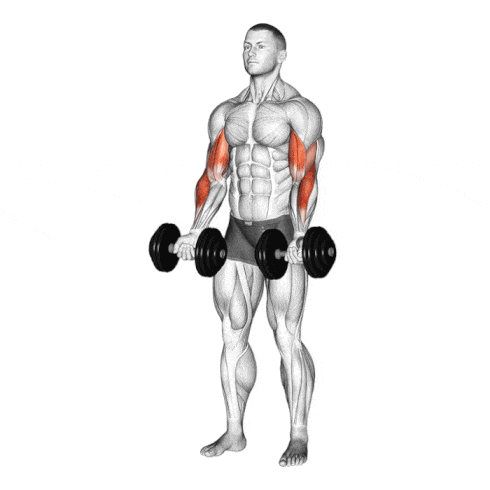
Execution Technique
- Hold a pair of dumbbells to your sides.
- Keep your palms facing up as you curl the weights up to your shoulders.
- Pause at the top of the movement.
- Slowly rotate your grip, so your palms are facing downwards.
- Lower the dumbbells slowly back to the starting position using an overhand grip.
- When the dumbbells are close to your thighs, again turn your hands while returning to the starting position.
How To Plan Dumbbell Back And Biceps Workout Routine
1. Select Sets And Reps
In this context, training volume refers to how much work we do for a particular body part. The simplest way to lay out volume is in terms of the sets being done.
Of course, the number of sets and reps will be determined based on the goal, but here is a great starting point:
Sets
- Beginners: ~10 sets per week.
- Intermediate: ~15 sets per week.
- Advanced: ~20 sets per week.
Reps
- 6-8 reps for strength
- 8-12 reps for hypertrophy
- 15-20+ for endurance
2. Select Workout Splits
You can use numerous workout splits that involve having a “back and biceps day”. However, they would all fall into one of two categories.
- A body part split: Workout routines that train related muscle groups on separate days.
- A Push Pull Legs split: Workout routines that train related muscle groups on the same day.
Body Part Routine Split
If you have a 4 or 5 day body part split:
- Day 1: Back and Bicep Workout
- Day 2: Chest and Tricep Workout
- Day 3: Legs and Shoulder Workout
- Day 4: Back and Bicep Workout
- Day 5: Chest and Tricep Workout
3. Back And Bicep Dumbbell Workout For Beginner
Below is an easy-to-understand back and bicep workout routine for beginners. This program consists of the primary back movements and will help you build a good base of muscle mass and strength.
| Exercise | Sets | Reps |
|---|---|---|
| Dumbbell Bent Over Row | 4 | 8-12 |
| Renegade Row | 4 | 10-12 |
| Dumbbell Deadlift | 3 | 8-10 |
| Dumbbell Curls | 4 | 8-10 |
| Hammer Curl | 3 | 8-10 |
4. Single Dumbbell Back And Bicep Workout Plan
| Exercise | Sets | Reps |
|---|---|---|
| One-Arm Dumbbell Row | 4 | 8-10 |
| Single Dumbbell Upright Row | 3 | 10-12 |
| Single Dumbbell Deadlift | 3 | 6-8 |
| One Arm Dumbbell Curls | 4 | 8-10 |
| Concentration Curl | 3 | 10-12 |
5. Back and Bicep Superset Workout Plan
- Dumbbell Bent Over Row: 4 sets of 8-12 reps, superset with,
- Dumbbell Curls: 4 sets of 6-8 reps.
- DB Upright Row: 3 sets of 10-12 reps, superset with,
- Hammer Curl: 3 sets of 8-10 reps.
- Renegade Row: 3 sets of 8-12 reps, superset with,
- Dumbbell Reverse Curl: 3 sets of 6-8 reps.
FAQs
is back and biceps a good workout?
Yes, you can train back and bicep together in your workout regime to gain mass. It’s preferred by many fitness gurus and bodybuilders to train them together, since you are already working the bicep when doing back.
How long should a back and bicep workout be?
There is no optimal time for a back and bicep workout. Generally, a workout routine lasts 45–90 minutes and shouldn’t take longer. Some people like to train fast, while others want to train slow.
Back and bicep Dumbbell workout Dumbbell at home
All the above exercises are the best options for a back and bicep dumbbell workout at home. Building your back and biceps is a sign of dominance, and these exercises can help you achieve a V-taper back and big gun.
How frequently should I train my back and bicep?
Since the back is a large group of muscles, you’ll have to be strategic about training it. It needs more attention than the biceps.
How often you train depends on the muscle, schedule, and goals.
So, if you can only make it to the gym once per week, you need to up your volume. But if you train twice-weekly, just train a muscle to the point of exhaustion and quit.
Conclusion
We’ve already introduced you to the best dumbbell back exercises and biceps exercises for building muscle mass.
I strongly encourage you to perform these exercises correctly, as that will greatly impact your progress.
You have also been shown three types of back and bicep workout routines—with a pair of dumbbells, with a single dumbbell, and as a superset.
You can try one of these and then let us know how it has worked.
- Paulo Gentil, Saulo Soares, and Martim Bottaro Single vs. Multi-Joint Resistance Exercises: Effects on Muscle Strength and Hypertrophy. Asian J Sports Med. 2015 Jun
- Strength and Conditioning Journal: October 2017 – Volume 39 – Issue 5 – p 33-35. Large and Small Muscles in Resistance Training: Is It Time for a Better Definition?
- J Strength Cond Res. 2020 May;34(5):1254-1263. Varying the Order of Combinations of Single- And Multi-Joint Exercises Differentially Affects Resistance Training Adaptations.
Best Back and Bicep Workout For Mass And Strength

Manish is a NASM-certified fitness and nutrition coach with over 10 years of experience in weight lifting and fat loss fitness coaching. He specializes in gym-based training and has a lot of knowledge about exercise, lifting technique, biomechanics, and more.
Through “Fit Life Regime,” he generously shares the insights he’s gained over a decade in the field. His goal is to equip others with the knowledge to start their own fitness journey.
